Art & Exhibitions
Editor’s Picks: 5 Queer Art Shows to See in NYC
A broad spectrum of art is on view at these New York LGBTQ- focused exhibitions. Here's are our must-see choices for a gallery crawl.
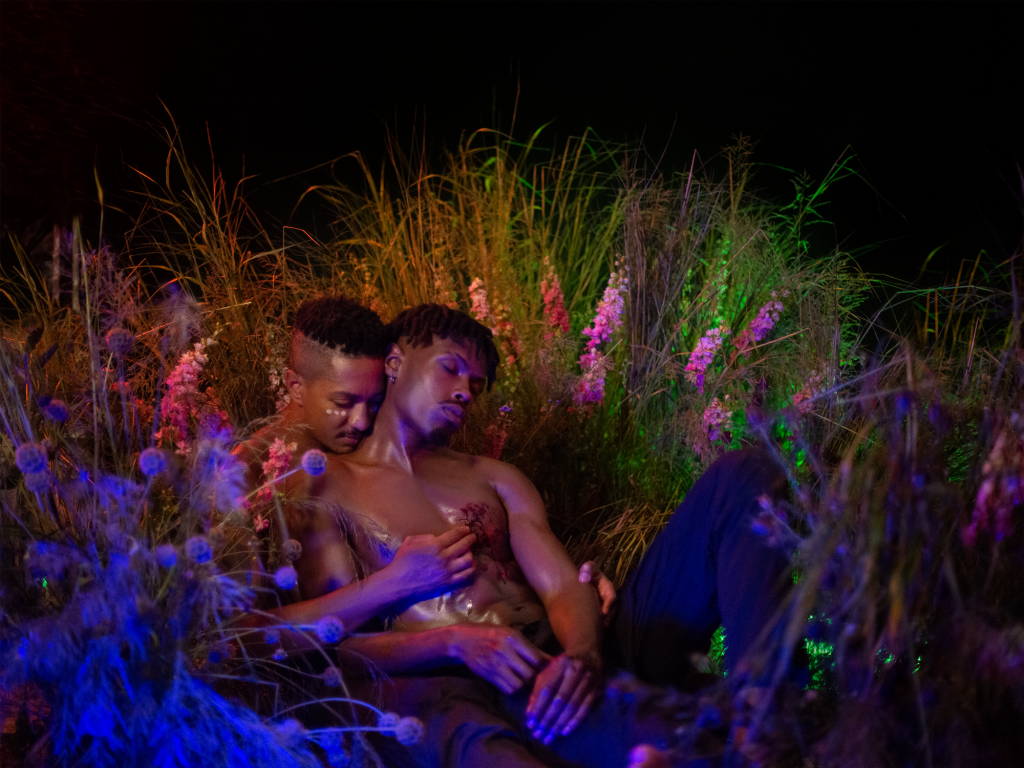
A broad spectrum of art is on view at these New York LGBTQ- focused exhibitions. Here's are our must-see choices for a gallery crawl.

William Van Meter

For homosexuals and other queer folks, dry January can make the start of the year feel like staring into a gaping maw. Luckily, there is a slew of invigorating New York art shows catering to a broad spectrum of tastes and moods. Thank the goddess! From disrobed rebels to poetic and somber parables, the LGBTQ art squad really threw down. What links all of these exhibitions is a shared element of storytelling and myth-making. They’re all compelling in their own way—and each propose a disparate desire.
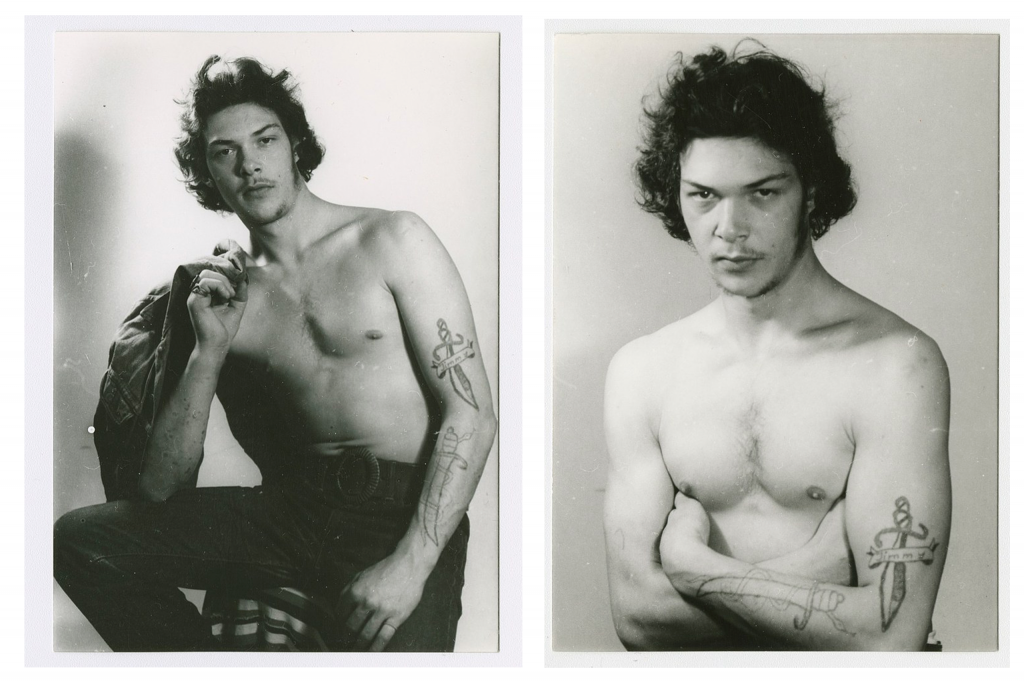
Karlheinz Weinberger, Portrait, (c. mid 1960s). Courtesy of Situations Gallery and the Karlheinz Weinberger Foundation
The Swiss photographer Karlheinz Weinberger is best known for his 1950s and 1960s images of the “Halbstark” subculture of beatniks, motorcycle gangs, and the big-haired ladies with questionable taste in men who love them; even if you’re unfamiliar with the images, you’ve certainly seen many fashion shoots that have hijacked them note-for-note since the ’90s. But Weinberger was much more prodigious with his personal stash of revealing rough trade portraits, which he made in the makeshift studio in the apartment he shared with his mother. “Subsequent Icons” showcases a series of sequential images of men disrobing from workwear and construction gear to nothing.
Gallery owner Jackie Klempay curated the exhibition. “I wanted to show the serial nature of the photos and imagine his interaction with these people in his mother’s home,” she said. “You see little bits of motorcycle jackets, boots, or helmets even while they’re totally nude. You can see the crossover between his interests. They’re not like Bob Mizer physique shots where they have perfect bodies. They have character.”
As a bonus, there’s a selection of unframed, one-off, full-frontal prints for sale. At the heart of Weinberger’s work is a fascination with vagabonds and rebels. “He’s portraying outsiders and people that have unconventional lives,” Klempay said. “That’s always attractive.”
“Subsequent Icons” is on view until February 25 at Situations, 127 Henry Street, NY, NY.
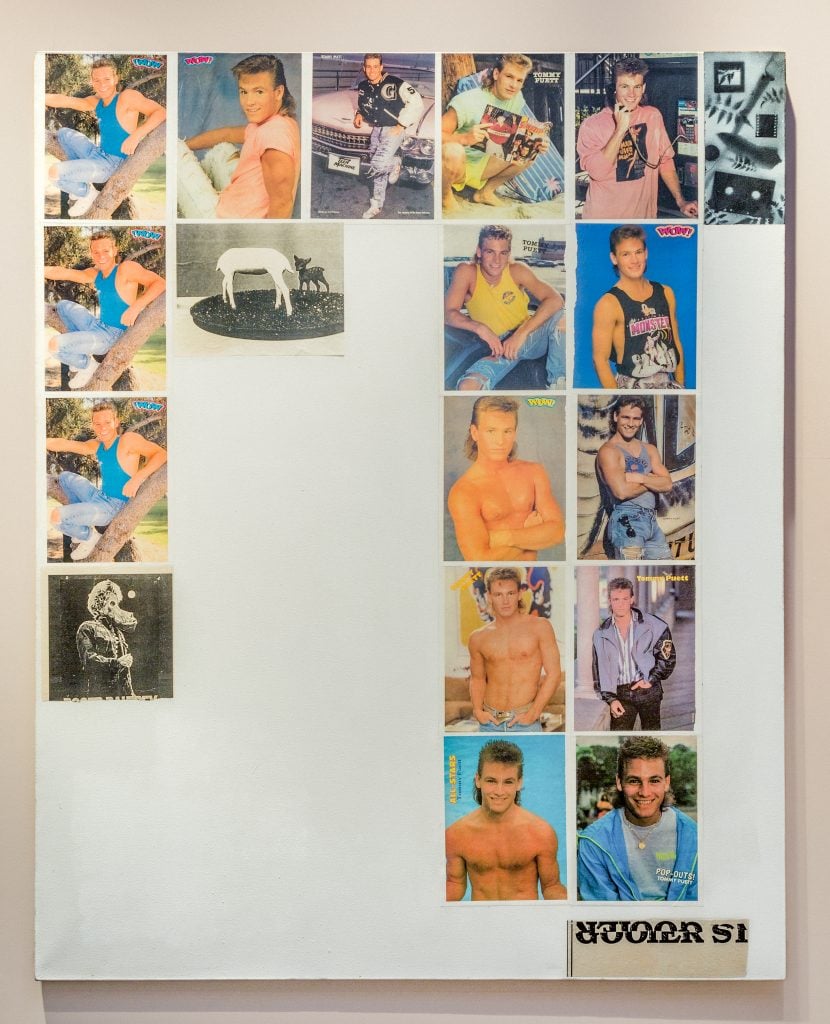
Mark Flood, Body in Space (1998). Courtesy of Elliott Templeton Fine Arts
“Tommy Puett,” a dynamo of masc bro blond mullet machismo, is chilling a few doors down at Elliott Templeton Fine Arts. Posing in a revealing tank or sprawled on the hood of a pink Cadillac, he looks like a ripped and raring-to-go 1991 porn bottom, featuring in these vintage late ’90s Mark Flood works. Yet Puett’s claim to fame was really as an actor on Life Goes On, a treacly prime-time ABC soap where he played the best friend to lead character Corky, who had Down’s Syndrome (Puett’s character met his tragic end drunk driving).
The portraits are lifted from teenie-bopper magazines—the divide between a 13-year-old girl and an adult gay man can indeed be very narrow. The artwork embodies equal parts sex jams and adolescent scrapbook obsessions as well as a touch of the unhinged and foreboding.
“I can act out my sex addiction or stay home and make art,” Flood explained in the 2020 artist monologue Mark Flood in the Nineties. Puett would pop up as a motif in Flood’s work throughout those years like a sun-kissed Zelig. Though the actor retired from Hollywood decades ago, perhaps grudgingly, he forever stars in Flood’s art. But who is the voyeur? Is it Flood or the viewer? Or is Puett watching us? Is he omniscient?
“Tommy Puett” is on view until February 11 at Elliott Templeton Fine Arts, 105 Henry Street, store #6, NY, NY.
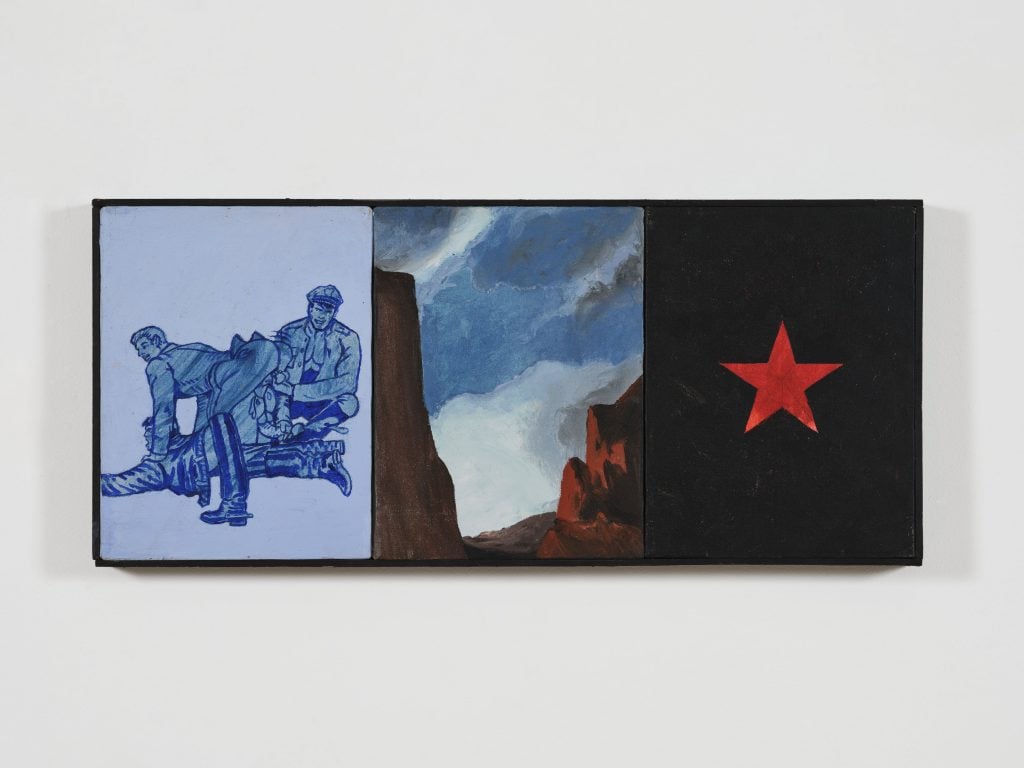
Brian Buczak Male Painting [View 1], (c. 1980). Courtesy Gordon Robichaux and Ortuzar Projects New York
Brian Buczak, who died of AIDS at age 33 in 1987, is getting his first solo exhibition since 1989 with a concurrent joint show at Gordon Robichaux in the Flat Iron and Ortuzar Projects in Tribeca with “Man Looks at the World.” Most of the works displayed had been hidden away for decades at the townhouse and studio he shared with his partner, the Fluxus artist Geoffrey Hendricks who passed in 2018 (Alice Neel painted the duo, and Hendricks commissioned Phillip Glass to compose a requiem piece for Buczak).
Buczak wielded an arsenal of mediums and styles, but the Gordon Robichaux component focuses on his usage of symbology that incorporated Masonic imagery, corporate logos, Buddhist philosophy, porn mags, comics, phallic tower and silos, as well as breathtaking vistas. It was as if he was trying to simplify and make sense of the sensory overload of modern life and his place in it (as well as his destiny), juxtaposing visions of the westward-ho American dream and scenic buttes next to a hardcore cop three-way. In his spare time, he’d stencil his runic language on abandoned buildings.
“Man Looks at the World” runs until February 17, at Gordon Robichaux, 41 Union Square West, #925 and #907 New York, NY and at Ortuzar Projects, 9 White Street, NY, NY.
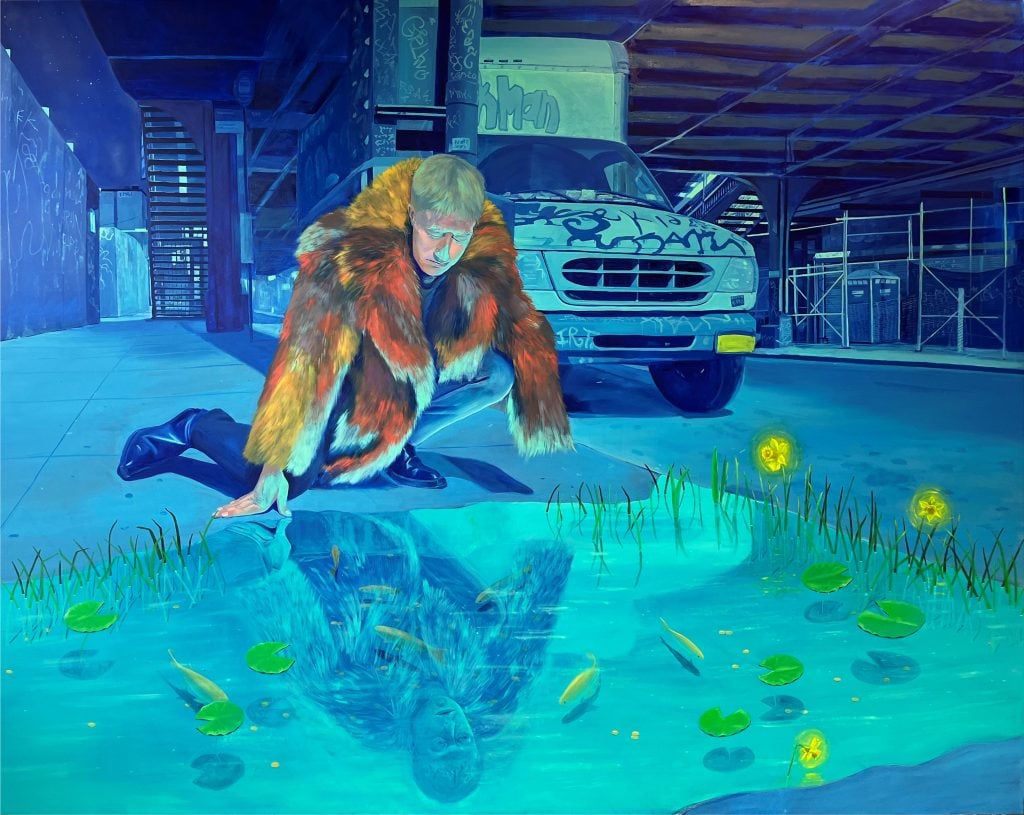
Linus Borgo, Narcissus at the Halsey Street Oasis, 2023 © Linus Borgo. Courtesy of the artist and Yossi Milo, New York.
In Chelsea, Linus Borgo’s enthralling debut solo show “Monstrum” is dense with mythos (both self-mythology and the ancient polytheistic sort). Borgo is a trans man who lost his hand in a near death experience his first year at RISD. The ramifications of this are rife in the work: Borgo deftly weaves between planes of existence, life, death, and the dream world in-between, piling up Renaissance master references and nods to the Greek pantheon next to glimpses of modernity. There is a gory element of soothsaying from reading animal entrails and a proud portrayal of the trans body clashing with scenes that correlate to societal vivisection.
Borgo himself makes frequent cameos, always staunchly depicting the reality of his hand—including multiple appearances as a merman—twice in the more classic sense, seemingly riffing off The Little Mermaid in the Copenhagen harbor whereas in another, he’s splayed out in a bathtub reminiscent of Darryl Hannah in Splash but with evident top surgery scars.
The work Narcissus at the Halsey Oasis depicts what looks like a late-night post-disco highway underpass revery—the subject is looking fly in his fur coat nightclub outfit and is looking at his reflection in a puddle. He doesn’t seem to see perfection in himself, but rather projects it onto the world and into this makeshift liquid mirror—the puddle is filled with flowers and lily pads instead of Brooklyn sludge.
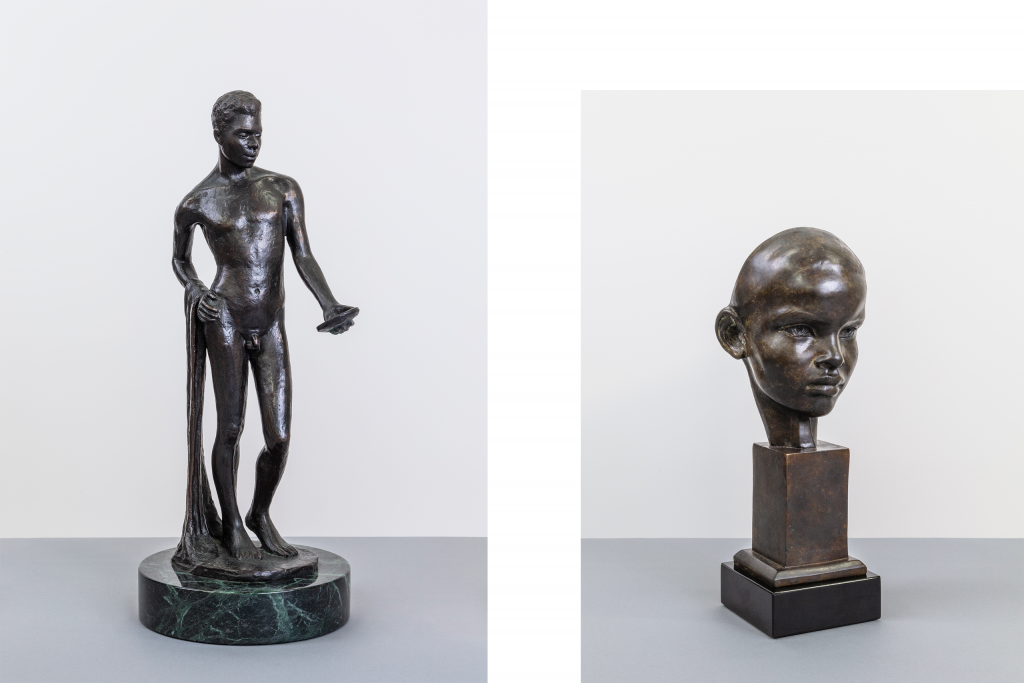
Richmond Barthé, Black Narcissus (1929) and Julius (1942). Courtesy of the estate of Dr. Samella Lewis and Ryan Lee Gallery.
Around the corner at Ryan Lee gallery, the 1929 sculpture Black Narcissus by Harlem Renaissance master Richmond Barthé (1901-1989) is a truly magnetic presence. (Barthé was the first Black artist to have work acquired by The Whitney). “In This Moisture Between Us Where the Guinep Peels Lay” is an intriguing dual show that pairs his sculptures with multimedia artist Christopher Udemezue, who was three when Barthé died.
“How he could make the Black male figure so strong, but so soft is something I thought about a lot,” said Udemezue, resplendent in a lace top and black cargo kilt, at last week’s opening. “I wanted to make the pictures have this kind of balance. How do we show Black men in this soft but very masculine way?” Both artists deal with Black figuration using very different methods of grace. Barthé’s work exudes spirituality; Udemezue channels and depicts it. “It makes sense on a spiritual level,” Udemezue said of the pairing.
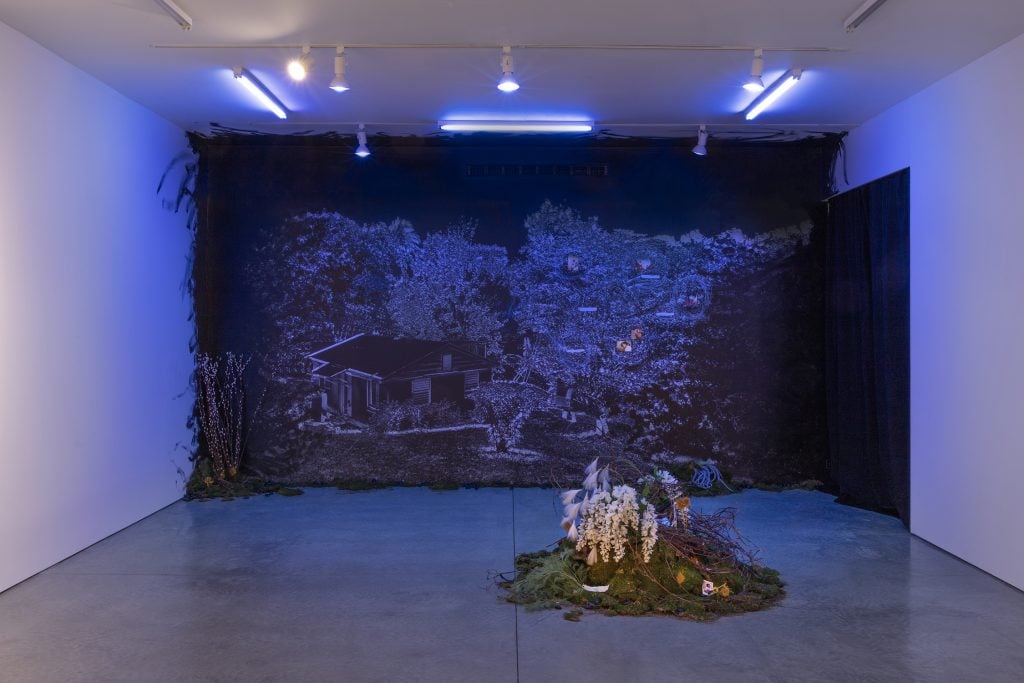
Richmond Barthé and Christopher Udemezue: in this moisture between us where the guinep peels lay installed at RYAN LEE, 2024.
The link between the two artists is Jamaica, which they both see as a place of healing and queer rebirth. Barthé decamped there in the wake of a nervous breakdown and stayed for decades. Udemezue’s family hails from the island nation, and he is also founder of RAGGA NYC, a platform connecting queer Caribbean artists.
The second room segues into a solo Udemezue outing and is where the artist really hits his stride, with his feet on the ground connecting narratively to the past while reaching for the cosmos. A wall is painted black and overlaid with a ghostly apparition of his family’s countryside house, a constellation of family photos hovers above. An assemblage of foliage and rocks is placed in the foreground. Orbiting the room are stylized images of a Technicolor queer utopian Jamaican fantasia, complete with pointed ear demigods and starry skied bliss.
“in this moisture between us where the guinep peels lay” is on view until March 9, at Ryan Lee, 515 West 26th Street, 3rd floor, NY, NY